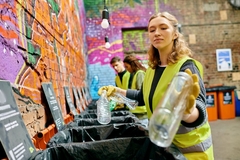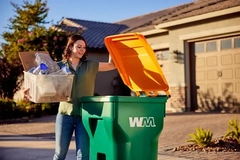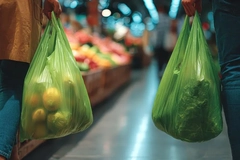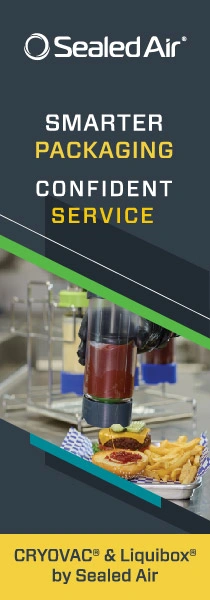Avantium CEO: Licensing strategy, capital access issues, YXY Technology and the bio-based future
12 Feb 2024 --- Avantium’s CEO Tom van Aken discusses the commercialization of its FDCA (furandicarboxylic acid) material.
FDCA is a raw material whose commercial applications include coating resins, adhesives, plasticizers, surfactants, polyamides, polyurethanes and the 100% plant-based polymer material PEF (polyethylene furanoate).
“FDCA has often been referred to as nature’s version of PTA (terephthalic acid) — this explains why there are so many application opportunities,” says Aken.
Avantium has developed a proprietary process technology — YXY Technology — to produce FDCA and is currently nearing completion of the construction of the world’s first commercial FDCA plant in Delfzijl, the Netherlands.
Van Aken talks to Packaging Insights about the company’s business model that involves sales of FDCA and PEF to offtake partners and challenges to commercialization rooted in regional differences in access to funding.
How does Avantium plan to sustain and expand commercial momentum in the coming years?
Van Aken: The growing demand for FDCA is fueled by an increased interest in using sustainable materials and continued technology improvements that have supported the development of these technologies. Avantium, in particular, has continued to telegraph its strategic focus on commercializing FDCA and PEF technology. It anticipates sustaining and expanding this commercial momentum by prioritizing the start of FDCA production in the second half of 2024, a central part of the strategy we recently shared with the market.  PEF can be used in multilayer PET bottles as a barrier material, replacing existing materials such as nylon.
PEF can be used in multilayer PET bottles as a barrier material, replacing existing materials such as nylon.
As we transition from a focus on R&D to commercialization, we expect to sustain this momentum by illustrating that our technology offers a superior product that will allow companies across many industries to achieve their goals of improving sustainability for the benefit of future generations. Offtake commitments for FDCA and PEF from 15 major brands — with more in the pipeline — give us confidence that the market is ready to embrace the versatility and potential of our new polymer.
Could you provide insights into the decision-making process behind Avantium’s business model?
Van Aken: Avantium’s business model is based on sales of FDCA and PEF to our offtake partners. In addition, we intend to sell technology licenses to industrial partners who are expected to build production capacities of more than 100 kilotons per annum based on our patents, and knowledge and experience derived from the operation of our FDCA Flagship Plant.
In February 2023, we announced the signing of our first technology licensing agreement with the US-based sustainable materials company Origin Materials. Pursuing a licensing strategy for our FDCA and PEF technology means we can use partners’ resources and capabilities to bring PEF to market more quickly, at a grander scale, and at more attractive prices.
Under the technology license agreement, Avantium is eligible for milestone payments and royalties for each metric ton of FDCA produced at the licensed plant. With this strategy, we have started monetizing our technology even as the flagship plant has been under construction. Rolling out our licensing strategy is the fastest way to deploy our FDCA and PEF technology worldwide.
Could you elaborate on the sustainability impact of Avantium’s YXY Technology?
Van Aken: PEF represents an ideal solution to substitute fossil-based monolayer plastic packaging. It can also be used in multilayer PET bottles as a barrier material, replacing existing materials such as nylon. The excellent barrier properties of PEF (the ability to withstand gas permeability through the bottle) lead to the multilayer bottle application to a full polyester (PET and PEF) product design for beverages such as carbonated drinks, juices or beer.  Avantium CEO says a materials transition is needed, moving the chemical industry away from its dependence on fossil-based resources.
Avantium CEO says a materials transition is needed, moving the chemical industry away from its dependence on fossil-based resources.
Replacing barrier materials like nylon leads to improved recyclability of the multilayer PET bottle. Nylon barrier material or MXD6 cannot be recycled and, if not removed, negatively impacts the quality of the recycled PET. Therefore, nylon or MXD6 is filtered out in the recycling stream and incinerated. The incineration of nylon releases vast amounts of CO2 and emissions, such as nitrogen, into the atmosphere.
In 2023, the Renewable Carbon Initiative published the Life Cycle Assessment (LCA) of the technology and our industrial PEF material. This LCA concluded that using PEF to produce 500 mL bottles would result in a 62% reduction in GHG emissions over the life cycle of the bottles compared to bottles of a similar volume made with PET.
In pursuing industrial-scale production, what challenges has Avantium encountered?
Van Aken: Funding is critical in helping us provide FDCA and PEF for creating plant-based, fossil-free applications. However, without this, we cannot fulfill our commercialization goals. We see substantial regional differences in terms of access to funding.
In Europe, for example, access to capital for financing high-risk and capital-intensive technologies remains a challenge. For a high-risk, capital-intensive company like ours, access to capital in the US seems many times easier. This doesn’t mean US-based bio-based chemical and material companies are more successful than their European peers. The European market for sustainable material technologies seems more advanced than other geographies, supported by new regulations.
What is Avantium’s vision for the future of FDCA and its applications?
Van Aken: When addressing climate change and circularity, most people only focus on the need for an energy transition. Most of us do not realize that it would not be possible to stay within the 1.5 degrees Celsius temperature rise without sharp reductions in emissions from the materials sectors, including the chemical and plastics industry, which accounts for around 4% of global greenhouse gas emissions, roughly equal to the output of Russia. In other words, we also need a materials transition, moving the chemical industry away from its dependence on fossil-based resources.
 The construction of the FDCA Flagship Plant in Delfzijl intends to start FDCA production in the second half of 2024.Biomaterials, such as our bioplastic PEF, offer an attractive alternative to fossil-based materials and processes. They also raise the bar of expectation with their environmental and performance properties. Making biomaterials commercially viable comes down to partnerships and collaborations across the value chain. Our vision of a greener world cannot be achieved alone. Collaboration between businesses, scientists and policymakers can help incite greater change and better engagement and education with the public on the impact of climate change. Most importantly, we need individuals to demand this switch from their favorite brands, adopt these alternatives in their daily lives and drive this change from the supermarket aisles and when shopping online.
The construction of the FDCA Flagship Plant in Delfzijl intends to start FDCA production in the second half of 2024.Biomaterials, such as our bioplastic PEF, offer an attractive alternative to fossil-based materials and processes. They also raise the bar of expectation with their environmental and performance properties. Making biomaterials commercially viable comes down to partnerships and collaborations across the value chain. Our vision of a greener world cannot be achieved alone. Collaboration between businesses, scientists and policymakers can help incite greater change and better engagement and education with the public on the impact of climate change. Most importantly, we need individuals to demand this switch from their favorite brands, adopt these alternatives in their daily lives and drive this change from the supermarket aisles and when shopping online.
What can you tell us about Avantium’s initiatives and plans in the pipeline?
Van Aken: We are excited about the prospect of producing commercial quantities of FDCA from our flagship plant, allowing us to unlock multiple licensing opportunities for the FDCA technology and build on our strategic plan. The construction of the FDCA Flagship Plant in Delfzijl continues progressing, and intends to start FDCA production in the second half of 2024 are on track. We will commission the FDCA Flagship Plant in phases, beginning in Q1 2024, followed by the sequential start-up of the different subunits of the Flagship Plant.
Furthermore, our Volta Technology shows great promise. Our Volta Technology uses electrochemistry to convert CO2 to high-value products and chemical building blocks, including glycolic acid. By combining glycolic acid with lactic acid, Avantium can produce polylactic-coglycolic acid (PLGA), a carbon-negative polymer with valuable characteristics: it has an excellent barrier against oxygen and moisture, has good mechanical properties, is recyclable and is both home compostable and marine degradable. This makes PLGA a more sustainable and cost-effective alternative to, for example, non-degradable, fossil-based polymers.
In 2023, we achieved significant progress on Volta Technology by signing agreements for two long-term strategic partnerships. First, with SCG Chemicals — a leading integrated chemical player in Asia — we are developing CO2-based polymers containing the glycolic acid produced by Volta Technology via electrochemical conversion. Under the second collaboration agreement, announced in August 2023, we will work with Norsk Hydro — a leading aluminum and renewable energy company — to develop Volta Technology further and harness its potential to deliver innovative and sustainable solutions for our partner.
By Radhika Sikaria











